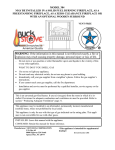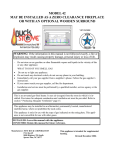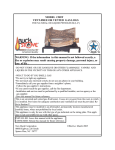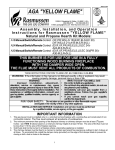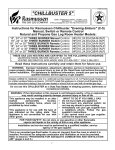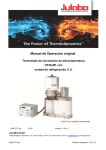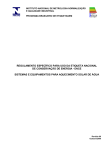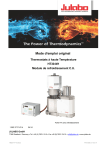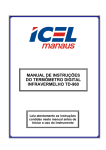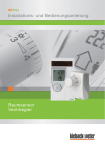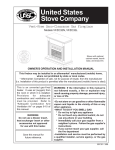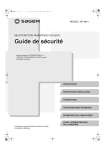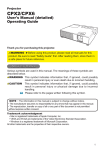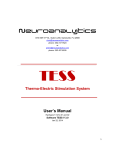Download New Buck Corporation MODEL FP-327-ZC User's Manual
Transcript
NEW BUCK CORPORATION MODEL FP-327-ZC WARNING: If the information in this manual is not followed exactly, a fire or explosion may result causing property damage, personal injury or loss of life. − Do not store or use gasoline or other flammable vapors and liquids in the vicinity of this or any other appliance. WHAT TO DO IF YOU SMELL GAS • • • • − Do not try to light any appliance. Do not touch any electrical switch; do not use any phone in your building. Immediately call your gas supplier from a neighbor’s phone. Follow the gas supplier’s instructions. If you cannot reach your gas supplier, call the fire department. Installation and service must be performed by a qualified installer, service agency or the gas supplier. This is an unvented gas-fired heater. It uses air (oxygen) from the room in which it is installed. Provisions for adequate combustion and ventilation air must be provided. Refer to section “ Producing Adequate Ventilation” page 14. This appliance may be installed in an aftermarket, permanently located, manufactured (mobile) home, where not prohibited by local codes. This appliance is only for use with the type of gas indicated on the rating plate. This appliance is not convertible for use with other gases. INSTALLER: Leave this manual with the appliance. CONSUMER: Retain this manual for future reference. Manufacturer: NEW BUCK CORPORATION P.O. Box 69 8000 Highway 226 South Spruce Pine, NC 28777 This appliance is intended for supplemental heating. “This heater shall not be installed in a bedroom or bathroom.” March 2005 TABLE OF CONTENTS Safety Information and Warnings ........................................................................................3 Installation ...........................................................................................................................6 Fireplace and Framing Dimensions .....................................................................................7 Fireplace Clearances ............................................................................................................8 Finishing Your Fireplace .....................................................................................................9 Mantel Profiles For Zero Clearance...................................................................................10 Mantel Installation ............................................................................................................11 Mobile Home Installation ..................................................................................................13 Producing Adequate Ventilation ........................................................................................14 Ventilation Air Indoors ......................................................................................................16 Ventilation Air Outdoors ...................................................................................................17 Gas Connection ..................................................................................................................18 Gas Pressure Check ...........................................................................................................19 Placement of Logs .............................................................................................................20 Lighting Instructions - Millivolt Valve ..............................................................................21 Lighting Instructions - Modulating Valve .........................................................................25 Flame Check ......................................................................................................................29 Wiring Diagram .................................................................................................................30 Important Safeguards .........................................................................................................32 Trouble Shooting ...............................................................................................................33 Service/Replacement Parts ................................................................................................37 Warranty/Owner Registration ............................................................................................42 Page 1 Page 2 SECTION I SAFETY INFORMATION WARNINGS IMPORTANT: READ THIS OWNER’S MANUAL CAREFULLY AND COMPLETELY BEFORE TRYING TO ASSEMBLE, OPERATE, OR SERVICE THE APPLIANCE. IMPROPER USE OF THESE LOGS CAN CAUSE SERIOUS INJURY OR DEATH FROM BURNS, FIRE, EXPLOSION, AND CARBON MONOXIDE POISONING. Early signs of carbon monoxide poisoning resemble the flu, with headaches, dizziness, and/or nausea. If you have these signs, the heater may not be working properly. Get fresh air at once! Have heater serviced. Some people-pregnant women, persons with heart or lung disease, anemia, those under the influence of alcohol, and those at high altitudes-are more affected by carbon monoxide than others. CAUTION: Strong drafts, such as a ceiling fan placed directly in front of the heater (pulling from either direction) may create sooting. Sooting will discolor walls. 1. The installation must conform with local codes ,or in the absence of local codes, with the National Fuel Gas Code, ANSI Z223.1/NFPA54. * 2. This appliance may be installed in an After-Market Manufactured (Mobile) Home, where not prohibited by state or local codes. * (After-Market: Completion of sale, not for purpose of resale from the manufacturer.) This appliance is only for use with the type of gas indicated on the rating plate. This appliance is not convertible for use with other gases. NOTE: See Section VII, “Producing Adequate Ventilation” page 14. IMPORTANT: VENT-FREE HEATERS ADD MOISTURE TO THE AIR. ALTHOUGH THIS IS BENEFICIAL, INSTALLING HEATER IN ROOMS WITHOUT ADEQUATE VENTILATION MAY CAUSE MILDEW TO FORM FROM TOO MUCH MOISTURE. 3. Never install this heater: ♦ in a recreational vehicle, bathroom, bedroom, or any other sleeping quarters ♦ where curtains, furniture, clothing, or other flammable objects are less than 42" from the front of the heater ♦ in high traffic areas or in windy areas 4. Two models are available. One specific model for propane (LP), and one for natural gas. Use the correct type gas for your home. Do not convert from one gas type to another. “WARNING: ANY CHANGE TO THIS HEATER OR ITS CONTROLS CAN BE DANGEROUS.” WARNING This appliance is equipped for (natural or propane) gas . Field conversion is not permitted. Page 3 5. If this heater is used with propane gas, do not place propane supply tank (s) inside any structure. 6. What To Do IF You Smell Gas: Shut off gas supply. - Do not try to light any appliance. - Do not touch any electrical switch; do not use any phone in your building. - Immediately call your gas supplier from a neighbor’s phone. Follow the gas supplier’s instructions. - If you cannot reach your gas supplier, call the fire department. 7. When operated for the first time, the logs may emit a “paper burning” smell. This smell will gradually diminish and will be totally eliminated after the first few hours of operation. Run the gas logs with the flue damper open during this time. Do not use blower at this time. 8. “This heater shall not be installed in a confined space or unusually tight construction unless provisions are provided for adequate combustion and ventilation air.” See “Producing Adequate Ventilation”, page 14. 9. Surface of gas logs becomes very hot when operating. Keep children and adults away from hot surface. Gas logs will remain hot for sometime after shutdown. Allow surface to cool before touching. 10. Do not place clothing or other flammable material on or near the appliance. 11. If equipped, fresh air damper must be closed. 12. Keep appliance area clean and free from combustible materials, gasoline, and other flammable flammable vapors and liquids. . 13. If burner shuts off, do not relight until you provide fresh outside air. If burner continues to shut off, have unit serviced. 14. Do not use this heater if any part has been under water. Immediately call qualified service technician to inspect the room heater and to replace any part of the control system and any gas control which has been under water. 15. Turn off the heater and let cool before servicing. 16. These logs are made of bonded fiber. When removing logs and base, do not damage the bonded material. If the material is damaged extensively, loose fiber dust could be emitted into the air. 17. Any safety screen or guard removed for servicing an appliance must be replaced prior to operating the heater. 18. This appliance is intended for supplemental heating. 18. “WARNING: Any change to this heater or its controls can be dangerous.” 19. Installation and repairs should be performed by a qualified service person. The appliance should be inspected before use and at least annually by a professional service person. More frequent cleaning may be required due to excessive lint from carpeting, bedding material, etc. It is imperative that control compartments, burners and circulating air passageways of the appliance be kept clean. Page 4 20. All heater screens must be kept clean when operating the gas logs. 21. . ”WARNING: Failure to keep the primary air opening(s) of the burner(s) clean may result in sooting and property damage.” 22. Do not use this heater for burning trash or cooking. Never place matches, paper, garbage, or any other material on top of logs or into the flames. 23. Do not install or operate this heater in areas where impurities in the air exist (such as tobacco smoke or heavy cooking grease). Particles from impurities may discolor walls. 24. Due to high temperatures, the appliance should be located out of traffic and away from furniture and draperies. 25. Children and adults should be alerted to the hazards of high surface temperature and should stay away to avoid burns or clothing ignition. 26. Young children should be carefully supervised when they are in the same room with the appliance. 27. An unvented room heater having an input rating of more than 10,000 Btu per hour shall not be installed in a bedroom or bathroom. 28. The appliance and its appliance main gas valve must be disconnected from the gas supply pipping system during any pressure testing of that system at test pressure in excess of 1/2 psi (3.5 kPa). 29. The appliance must be isolated from the gas supply pipping system by closing its equipment shut-off valve during any pressure testing of the gas supply piping system at test pressures equal to or less than 1/2 psi (3.5 kPa). 30. “WARNING: Do not allow fans to blow directly into fireplace. Avoid any drafts that alter burner flame patterns.” 31. “WARNING: Do not use a blower insert, heat exchanger insert or other accessory not approved for use with this heater.” Page 5 SECTION II ZERO CLEARANCE INSTALLATION The installation must conform with local codes ,or in the absence of local codes, with the National Fuel Gas Code, ANSI Z223.1/NFPA54. * This appliance may be installed in an After-Market Manufactured (Mobile) Home, where not prohibited by state or local codes. * (After Market: Completion of sale, not for the purpose of resale from the manufacturer). This appliance is only for use with the type of gas indicated on the rating plate. This appliance is not convertible for use with other gases. NOTE: See “Producing Adequate Ventilation” page 14. CHOOSING THE LOCATION FOR YOUR FIREPLACE: Figure 1 shows some of the many ways your fireplace may be installed. Consider the traffic pattern in your room and the location of doors and windows. Moving air from ceiling fans, open doors, and hot air grills may cause the flames to soot. If a disturbance is found that affects the flames, it must be eliminated by turning off the ceiling fan, closing the door, or closing or moving the hot air register. A corner location may be best where space is limited. Your fireplace weighs no more than some of your fine furniture. If the fireplace is located near a load bearing wall, additional supports to the foundation will not be necessary. HEAVY FACINGS, SUCH AS BRICK, STONE, ETC., MAY REQUIRE ADDITIONAL FOUNDATION SUPPORT. NOTE: If this appliance is installed directly on carpeting, tile or other combustible material, other than wood flooring, the appliance shall be installed on a metal or wood panel extending the full width and depth of the appliance. GAS LINE The gas supply line and electrical supply must be installed before framing in the fireplace by a licensed installer. DRAFTS Do not locate the fireplace in high traffic areas or areas exposed to high drafts and winds. Locate the fireplace away from furniture and draperies. Page 6 Fireplace and Framing Dimensions (inches) NOTE: Do not obstruct air openings around appliance. Maintain adequate clearances around air openings. 32 3/16" 15 3/4" 26 1/4" 30 3/16" GAS LINE 31 7/8" 31 7/8" 3 1/4" 7 1/2" 32 3/16" 13 1/2" Figure 2 WARNING: Installation and repairs should be performed by a qualified service person. The appliance should be inspected before use and at least annually by a professional service person. More frequent cleaning may be required due to excessive lint from carpeting, bedding material, etc. It is imperative that control compartments, burners and circulating air passageways of the appliance be kept clean. Page 7 any combustible material other than wood flooring, it must be installed on a metal or wood panel extending its The fireplace may be placed directly on a combustible floor, against a combustible wall at marked clearances, or full width and depth. Alternatively, the carpeting, vinyl tile, etc. may be removed beneath the fireplace before on a raised wooden platform. installing. If the fireplace is to be installed on a raised wooden MATERIALS MUST NOT BE INSTALLED platform, the platform must be a continuous level surface. COMBUSTIBLE OVER OR TOUCH ANY BLACK PAINTED SURFACE. DO The fireplace must be secured in place so it cannot shift NOT BLOCK HEAT CIRCULATING AIR OUTLETS. DOING positions. The nailing flanges on the sides of the firebox SO MAY RESULT IN POTENTIAL FIRE HAZARDS. make securing it to the framing easy. They were designed 1. Sidewall Clearances: Clearances from the side of the to allow the installation of 1/2" wallboard or plywood flush fireplace opening to any adjacent combustible wall with the face of the fireplace. should not be less than 7"right side, 7” left side. Only the header (see Figure 2) may rest on the standoffs 2. Ceiling Clearances: The ceiling height should on top of the firebox. not be less than 42" from the top of the fireplace When the firebox is installed over carpeting, vinyl tile, or opening. FIREPLACE CLEARANCES INSTALLING THE FIREBOX This list of specific instructions will help you make certain that every installation operation is performed correctly. Complete the installation steps in the sequence shown. for the fireplace by taking into consideration the factors previously outlined in the “Choosing the Location.” See page 6. Framing the Firebox The width of the framed opening must be 31 7/8". The height of the framed opening must be 32 3/16". The entire fireplace can be elevated above the floor to achieve a raised hearth effect. This can be done by adding a small platform to achieve the desired height. NOTE: The wiring for the lower blower must be installed during the framing stage. The nailing flanges on both sides were designed to allow the installation of 1/2" wallboard or plywood flush with the face of the fireplace. When the framing is inside, the outside wall will be insulated. If the framing or chase is outside, thin insulation should be used in the framing on the back, sides, and top. The bottom should be insulated with a hard insulating board. This will prevent cold from going into the chase through the fireplace to the living space. Install the Firebox Install the firebox into the framed opening by placing it directly in front of the opening and sliding it into the proper position. Level the Firebox Check the level of the firebox on the top edge of the fireplace face. Shim if necessary. Secure the Firebox Secure the fireplace to the framing. The nailing flanges on the firebox will make securing the firebox to the frame quick and easy. Use appropriate size nails or screws to secure the firebox. Page 8 1/2" 25" LOCAL BUILDING CODES SHOULD BE CONSULTED IN ALL CASES AS TO THE PARTICULAR REQUIREMENTS CONCERNING THE INSTALLATION OF FACTORY BUILT FIREPLACES. Select the location 13 1/2" LEFT FRONT *7" 31 7/8" *Note: Minimum 1/2" clearance SIDE VIEW 13 1/2" 32 3/16" FRONT VIEW FRAMING HEADER 32 3/16" 31 7/8" RIGHT FINISHING YOUR FIREPLACE There is a wide variety of finishing material available for your fireplace from formal wall treatments with marble and mantels, to rustic wood paneling, stone or brick. Noncombustible materials used in this installation such as slate, tile, marble, etc. must be at least 1/2" thick. brick and stone are made of non combustible materials before using them on the face of the fireplace. Some of these products contain combustible materials. Combustible wall coverings such as paneling or wallboard may not overlap the black face of the fireplace. The space between the wall covering and the fireplace should be sealed with a heat resistant material such as rock, wool, insulation or mortar. NOTE: An “L” shaped steel lintel must be installed across the top of the firebox opening where facing materials such as brick or stone is used on the face of the firebox. It acts as a support/firestop. It should be attached to the face of the fireplace with screws and sealed to the fireplace with a heat-resistant sealer. IT IS IMPORTANT THAT THE BLACK FACE OF THE FIREPLACE NOT BE COVERED WITH ANY TYPE OF COMBUSTIBLE MATERIAL. Non-combustible facing materials such as marble, brick, or ceramic tile may overlap the black face of the fireplace up to the opening on either side of the fireplace. Seal all joints between the black fireplace face and the wall covering with a heat-resistant material such as rock, wool, insulation or mortar. Be sure to use high temperature adhesive or mortar when anchoring brick, stone, or tile to the face of the fireplace. Check to see whether man-made CLEARANCES To ensure a safe installation, the following must be carefully observed. 1. Sidewall Clearances: Clearances from the side of the fireplace opening to any adjacent combustible wall should not be less than 7"right side, 7” left side. See Figure 4. 2. Ceiling Clearances: The ceiling height should not be less than 42" from the top of the fireplace opening. 3. Mantel Clearances: We have provided 3 different situations to position your mantel. See Figure 5. 4.Floor Clearances: No clearance is required if the appliance is installed per these instructions. 5. Front Clearances: 24” to combustible Materials. FIGURE 4 7" MIN. CLEARANCE TO SIDE WALL 2"NON-COMBUSTIBLE MATERIAL 42"MIN. CLEARANCE TO CEILING SIDE WALL RIGHT SIDE LEFT SIDE FRONT Page 9 24” MIN. TO COMBUSTIBLE MATERIALS MANTEL PROFILES FOR ZERO CLEARANCE CABINET MUST BE FOLLOWED MANTEL 3/4" FLAT SURFACE CEILING NAILING FLANGE PICTURE. 1 COMBUSTIBLE MATERIAL 42" 3" 3 1/4" 2" 3/4" 3 1/4" 7” 2" FP-327-ZC STAND OFF 10” TOP TRIM (METAL) LOUVERS 2" HOOD MANTEL 3/4" FLAT SURFACE CEILING NAILING FLANGE PICTURE. 2 3" COMBUSTIBLE MATERIAL 12" 42" 3/4" 2" 13” 10" 2" FP-327-ZC STAND OFF TOP TRIM (METAL) LOUVERS 2" HOOD 2 1/2" FLAT SURFACE CEILING NAILING FLANGE PICTURE. 3 COMBUSTIBLE MATERIAL 42" MIN. 6" 2" 2-1/2" STAND OFF TO 12" 8” 5" MIN. 2" FP-327-ZC TOP TRIM (METAL) LOUVERS 2" HOOD Figure 5 Page 10 INSTALLATION OF MODEL FP - 327- ZC WITH OPTIONAL WOODEN MANTEL (1) When choosing the right location for your heater and mantel keep the following in mind: NOTE: Due to high temperatures, this heater should be located out of traffic areas and away from furniture and draperies. NOTE: Kit No. (PAKDM327) Optional Wooden Mantel for FP-327-ZC. CAUTION: THE INSTALLATION MUST CONFORM WITH LOCAL CODES OR, IN THE ABSENCE OF LOCAL CODES, WITH THE NATIONAL FUEL GAS CODES, ANSI Z223.1/NFPA 54. NOTE: See page 18 for “Gas Connection” and page 19 for “Gas Pressure Check”. WARNING: YOUNG CHILDREN SHOULD BE CAREFULLY SUPERVISED WHEN THEY ARE IN THE SAME ROOM WITH THE APPLIANCE. DO NOT PLACE CLOTHING OR OTHER FLAMMABLE MATERIAL ON OR NEAR THE APPLIANCE (2) Screen(s) can not be removed or altered (Position screen(s) in the closed position before leaving heater unattended). (3) Follow instructions for assembly of (Optional) Wooden Mantel. See instructions supplied with mantel. (4) After mantel has been assembled, slide the heater from the rear into the opening of the mantel. NOTE: Place a cloth or blanket over the front portions of the mantel as not to scar the wood. (5) Center the heater in the opening of the mantel. See Figure 6. (6) Fasten mantel to hearth by using 1/2" wood screws. (7) Insert the nine (9) wood screws provided with mantel through slots on nailing flange and secure in place. See Figure 6. (8) Position mantel and fireplace into desired location. NOTE: Hook gas supply line into heater. Check for leaks using soap and water, not an open flame. NOTE: At this point, you may want to anchor the mantel to the wall or floor. (9) Now you are ready to position the log set. Page 11 (10) To light the heater, see “Lighting Instructions” pages 21 through 28. Make sure you have the right gas valve for Natural or LP gas. TOP MANTEL 1/2" WOOD SCREWS (9) MANTEL BASE FIGURE 6 Page 12 SIDE MANTEL REAR OF HEATER SECTION VI AFTER MARKET MOBILE HOME INSTALLATION NOTE: See “Producing Adequate Ventilation” page 14. .THIS APPLIANCE MAY BE INSTALLED IN AN AFTERMARKET*, PERMANENTLY LOCATED, MANUFACTURED (MOBILE) HOME, WHERE NOT PROHIBITED BY LOCAL CODES. *After Market: Completion of sale, not for the purpose of resale from the manufacturer. THIS APPLIANCE IS ONLY FOR USE WITH THE TYPE OF GAS INDICATED ON THE RATING PLATE. THIS APPLIANCE IS NOT CONVERTIBLE FOR USE WITH OTHER GASES. NOTE: For mobile home installation follow “Installation This Instruction Manual”. NOTE: See “Producing Adequate Ventilation” page 14 Page 13 PRODUCING ADEQUATE VENTILATION This section is for residential or manufactured (mobile) installation “This heater shall not be installed in a confined space or unusually tight construction unless provisions are adequate combustion and ventilation air.” The National Fuel Gas Code, ANSI Z223.1/NFPA 54 defines a confined space as a space whose volume is less than 50 cubic feet per 1,000 BTU per hour (4.8m 3 per kw) of the aggregate input rating of all appliances installed in that space and an unconfined space as a space whose volume is not less than 50 cubic feet per 1,000 BTU per hour (4.8m 3 per kw) of the aggregate input rating of all appliances installed in that space. Rooms communicating directly with the space in which the appliances are installed, through openings not furnished with doors, are considered a part of the unconfined space. “WARNING: IF THE AREA IN WHICH THE HEATER MAY BE OPERATED IS SMALLER THAN THAT DEFINED AS AN UNCONFINED SPACE OR IF THE BUILDING IS OF UNUSUALLY TIGHT CONSTRUCTION, PROVIDE ADEQUATE COMBUSTION AND VENTILATION AIR BY ONE OF THE METHODS DESCRIBED IN THE NATIONAL FUEL GAS CODE, ANSI Z223.1/NFPA 54, SECTION 5.3 OR APPLICABLE LOCAL CODES.” Unusually tight construction is defined as construction where: a) Walls and ceilings exposed to the outside atmosphere have a continuous water vapor retarder with a rating of 1 perm (6 x 10-11 kg per pa-sec-m2) or less with openings gasketed or sealed; b) Weather stripping has been added on openable windows and doors, and c) Caulking or sealants are applied to areas such as joints around window and door frames, between sole plates and floors, between wall-ceiling joints, between wall panels, at penetrations for plumbing, electrical, and gas lines, and at other openings. NOTE: SOME AREAS IN THE UNITED STATES HAVE HIGHER REQUIREMENTS FOR CUBIC FEET PER 1000 BTU/ HOUR INPUT. (EX. CINCINNATI, OHIO CODES REQUIRE 70 CUBIC FEET). CHECK YOUR LOCAL CODE BEFORE INSTALLATION. DETERMINING FRESH-AIR FLOW FOR HEATER LOCATION DETERMINE IF YOU HAVE A CONFINED OR UNCONFINED SPACE Use this worksheet to determine if you have confined or unconfined space. SPACE: Includes the room in which you will install heater plus adjoining rooms with doorless passageways or ventilation grills between the rooms. Page 14 1. Determine the volume of the space (length x width x height). Length x Width x Height =_________cu.ft.(volume of space) EXAMPLE: 20 ft.(Length) x 16 ft.(Width) x 8 ft.(ceiling Height)= 2560 cu. ft. (volume of space) If additional ventilation to adjoining room is supplied with grills or openings, add the volume of these rooms to the total volume of the space. 2. Divide the space volume by 50 cubic feet to determine the maximum BTU/Hr the space can support. _________(volume of space)/50 cu. ft. =maximum BTU/Hr the space can support) EXAMPLE: 2560 cu. ft. (volume of space /50 cu. Ft .= 51.2 or 51200 (maximum BTU/Hr the space can support) 3. Add the BTU/Hr of all fuel burning appliances in the space. Vent-free heater _______________BTU/Hr Gas water heater* _______________BTU/Hr Gas furnace _______________BTU/Hr Vented gas heater _______________BTU/Hr Gas fireplace logs _______________BTU/Hr Other gas appliances* + _______________BTU/Hr Total = _______________BTU/Hr Example: Gas water heater 40000 BTU/Hr Vent-free heater + 18000 BTU/Hr Total = 58000 BTU/Hr *Does not include direct-vent gas appliances. Direct-vent draws combustion air from the outdoors and vents to the outdoors. 4. Compare the maximum BTU/Hr the space can support with the actual amount of BTU/ Hr used. ____________BTU/Hr (maximum the space can support) ____________BTU/Hr (actual amount of BTU/Hr used) Example: 51200 BTU/Hr (maximum the space can support) 58000 BTU/Hr (actual amount of BTU/Hr used) The space in the above example is a confined space because the actual BTU/Hr used is more than the maximum BTU/Hr the space can support. You must provide additional fresh air. Your options are as follows: A. Rework worksheet, adding the space of an adjoining room. If the extra space provides an unconfined space, remove door to adjoining room or add ventilation grills between rooms. See “Ventilation Air From Inside Building”, page 16. B. Vent room directly to the outdoors. See “Ventilation Air From Outdoors”, page 17. C. Install a lower BTU/Hr heater, if lower BTU/Hr size makes room unconfined. If the actual BTU/Hr used is less than the maximum BTU/Hr the space can support, the space is an unconfined space. You will need no additional fresh air ventilation. WARNING: YOU MUST PROVIDE ADDITIONAL VENTILATION AIR IN A CONFINED SPACE Page 15 VENTILATION AIR VENTILATION AIR FROM INSIDE BUILDING This fresh air would come from an adjoining unconfined space. When venting to an adjoining space, you must provide two permanent openings: one within 12" of the ceiling and one within 12" of the floor on the wall connecting the two spaces (see Options 1 and 2, Figure 7). You can also remove door into adjoining room (see Option 3, Figure 7). WARNING REWORK WORKSHEET, ADDING THE SPACE OF THE ADJOINING UNCONFINED SPACE. THE COMBINED SPACES MUST HAVE ENOUGH FRESH AIR TO SUPPLY ALL APPLIANCES IN BOTH SPACES. NOTE: Each opening shall have a minimum free area of 1 square inch per 1000 BTU’s per hour of the total input ratings of all gas utilization equipment in the confined space, but not less than 100 square inches. Figure 7 Ventilation Air From Inside Building Page 16 WARNING THIS APPLIANCE MUST HAVE FRESH AIR FOR PROPER OPERATION. IF NOT, POOR FUEL COMBUSTION COULD RESULT. READ THE FOLLOWING INSTRUCTIONS TO ENSURE PROPER FRESH AIR FOR THIS AND OTHER FUELBURNING APPLIANCES IN YOUR HOME. VENTILATION AIR FROM OUTDOORS Provide extra fresh air by using ventilation grills or ducts. You must provide two permanent openings: one within 12" of the ceiling and one within 12" of the floor. Connect these items directly to the outdoors. These spaces include attics and crawl spaces. Follow the National Fuel Gas Code NFPA 54/ANSI Z223.1, Section 5.3, “Air For Combustion and Ventilation” for required size of ventilation grills or ducts. IMPORTANT: Do not provide openings for inlet air into attic if attic has a thermostatcontrolled power vent. Heated air entering the attic will activate the power unit. VENTILATED ATTIC OUTLET AIR TO ATTIC OUTLET AIR TO CRAWL SPACE INLET AIR VENTILATED CRAWL SPACE INLET AIR FIGURE 8 Page 17 WARNING: ANY CHANGE TO THIS HEATER OR ITS CONTROLS CAN BE DANGEROUS GAS CONNECTION Check gas type. Use only the type of gas indicated on the valve rating plate. If the gas type listed on the plate is not your type of gas supply, DO NOT INSTALL. Contact your dealer for proper model. Always use an external regulator for all LP heaters to reduce the supply tank pressure to a maximum of 13" W.C. This is in addition to the regulator furnished with the heater. WARNING: CONNECTION DIRECTLY TO AN UNREGULATED LP TANK CAN CAUSE AN EXPLOSION. The normal gas connection is 3/8" N.P.T. made at the left side (facing the front of the appliance) of the appliance. If a right side connection is desired, the connecting pipe may be led under the rear of the burner base to terminate at the right side for connection to the inlet of the valve. NOTE: The connecting pipe must be internally tinned copper tubing for use with natural gas. Test for leaks using a solution of soap and water after completing the connection. DO NOT USE OPEN FLAME. NOTE: “If the factory-built fireplace has no gas access hole(s) provided, an access hole of 1.5 inch (37.5mm) diameter or less may be drilled through the lower sides or bottom of the fire box in a proper workmanlike manner. This access hole must be plugged with non-combustible insulation after the gas supply line has been installed.” WARNING: Installation and repairs should be performed by a qualified service person. The appliance should be inspected before use and at least annually by a professional service person. More frequent cleaning may be required due to excessive lint from carpeting, bedding material, etc. It is imperative that control compartments, burners and circulating air passageways of the appliance be kept clean. Page 18 GAS PRESSURE CHECK Check the inlet pressure to the burner to ensure that it is as shown in the table below. NOTE: The pressure check point is located on the right side of the valve facing burner, for ITT, and the left side for SIT. The appliance and its appliance main gas valve must be disconnected from the gas supply piping system during any pressure testing of that system at test pressures in excess of 1/2 psi (3.5kPa). The appliance must be isolated from the gas supply piping system by closing its equipment shut-off valve during any pressure testing of the gas supply piping system at test pressures equal to or less than 1/2 psi (3.5 kPa). MODEL Gas Maximum Heat Input Gas Inlet Pressure: Maximum Minimum Manifold Pressure FP-327-ZC Natural ITT Maxitrol 27,000 27,000 FP-327-ZC Propane ITT Maxitrol 27,0000 27,000 10.5 ins. W.C. * 5 ins. W.C. 3.5 ins. W.C. 13 ins. W.C. *11 ins. W.C. 9 ins. W.C. NOTE: On initial installation it may be necessary to bleed out air in the gas lines. Do this by holding the control knob and turning the knob to the “PILOT” position for about 30 seconds. To check the Regulator pressure, remove the pressure tag plug at the left side of the Regulator facing the heater. The pressure should be checked with the heater burning and the control set on high. After measuring the pressure, replace the pressure tap plug, ensuring that there are no leaks. * For the purpose of minimum input adjustment. WARNING This appliance is equipped for (natural or propane) gas. Field conversion is not permitted. PLACEMENT OF LOGS CERAMIC LOGS (1) REAR LOG (2) FRONT LOG (3) LEFT TOP LOG WARNING: POSITIONING OF LOGS IS VERY CRITICAL (FIGURE 9). LOG PLACEMENT FOR CR8T LOG SET. 1. Place Rear log #1 on rear log support. The log has an alignment notch on Left and right corners. 2. Place Front log #2 with alignment notches over front andirons. 3. Left Top log has locating hole in one end, place hole over pin on Left side of Rear log (#1) . Make sure Front of Left Top log (#3) is resting on Left side of Left Andiron. SEE DIAGRAM ON PAGE 20. Page 19 PLACEMENT OF LOGS 3 1 2 Figure 9 WARNING:FAILURE TO POSITION THE PARTS IN ACCORDANCE WITH THESE DIAGRAMS OR FAILURE TO USE ONLY PARTS SPECIFICALLY APPROVED WITH HEATER MAY RESULT IN PROPERTY DAMAGE OR PERSONAL INJURY. WARNING: DO NOT ALLOW FANS TO BLOW DIRECTLY INTO THE FIREPLACE. AVOID DRAFTS THAT ALTER BURNER FLAME PATTERN. Page 20 LIGHTING INSTRUCTIONS MILLIVOLT VALVE (ITT) FOR YOUR SAFETY, READ BEFORE LIGHTING WARNING IF YOU DO NOT FOLLOW THESE INSTRUCTIONS EXACTLY, A FIRE OR EXPLOSION MAY RESULT CAUSING PROPERTY DAMAGE, PERSONAL INJURY, OR LOSS OF LIFE. A. This appliance has a pilot which must be lighted by hand. When lighting the pilot, follow these instructions exactly. B. BEFORE LIGHTING smell around the appliance for gas. Be sure to smell next to the floor because gas is heavier than air and will settle on the floor. ♦ ♦ ♦ ♦ WHAT TO DO IF YOU SMELL GAS Do not try to light any appliance. Do not touch any electrical switch; do not use any phone in your building. Immediately call your gas supplier from a neighbor’s phone. Follow the gas supplier’s instructions. If you cannot reach your gas supplier, call the fire department. C. Use only your hand to push in or turn the gas control knob. Never use tools. If the knob will not push in or turn by hand, don’t try to repair it, call a qualified service technician. Force or attempted repair may result in a fire or explosion. D. Do not use this appliance if any part has been under water. Immediately call a qualified service technician to inspect the appliance and to replace any part of the control system and any gas control which has been under water. Page 21 LIGHTING INSTRUCTIONS 1. STOP! Read the safety information on previous page. 2. Make sure the manual shutoff valve is fully closed.If equipped with thermostat set to the lowest setting. 3. Turn off all electrical power to the appliance. 4. Open access panel door located at bottom front of the appliance. 5. Turn control knob clockwise to the full “OFF” position. ROCKER SWITCH GEN R ES ET O IGNITOR ELECTRODE PILOT BURNER PIEZO GENERAL ITT CONTROLS PRESST AUX PILOT ADJ THERMO N OFF ON T O O PIL OFF ITT VALVE THERMOGENERATOR THERMOPILE BURNER CONTROL KNOB BEFORE INSTALLING THERMOSTAT REMOVE METAL CONNECTOR PILOT PILOT ASS'Y 50 60 70 80 90 THERMOSTAT When hooking up a Wall Thermostat to valve, remove the Jumper Bar. Do not remove the existing wires, simply add the wire from the Wall Thermostat to screws (one wire to each screw). 6. Wait five (5) minutes to clear out any gas. Then smell for gas, including near the floor. If you smell gas, STOP! Follow “B” in the safety informationon the previous page.If you don’t smell gas, go to the next step. 7. Find Pilot: The pilot is located in front of the rear log and burner on the right hand side of the appliance. Fully open the manual shutoff valve. 8. Push the ON/OFF toggle switch to “OFF” (rocker switch). 9. Turn gas control knob counterclockwise to the “PILOT” position.Press in gas control knob for fifteen (15) seconds. 10. With control knob pressed in , push down (in) and release the ignitor button (ignitor button is located on the left hand side of the front of the appliance). This will light the pilot. If needed, keep repeating this step until pilot lights. 11. Keep control knob pressed in for (1) one minute after lighting pilot. After (1) minute, release the gas control knob and it will pop back up. Pilot should remain lit. If pilot goes out, repeat steps 1 through 9. • If the knob does not pop up when released, stop and immediately call your service technician or gas supplier. Page 22 • If the pilot will not stay lit after several tries, turn the gas control knob to “OFF” and call your service technician or gas supplier. IGNITOR ELECTRODE PILOT BURNER THERMO-COUPLE THERMO-PILE 12. 13. 14. 15. Turn control knob counterclockwise to the “ON” position. Push the “ON/OFF” toggle switch to the “ON” position. The main burner should light. Close access panel door. Turn on all electrical power to the appliance. Set thermostat to desired setting. NOTE: This unit may be used with an optional Wall Thermostat. If so, the Wall Thermostat needs to be set at a higher temperature than the room temperature. TO TURN OFF GAS TO APPLIANCE SHUTTING OFF UNIT 1. Open access panel door located at bottom front of the appliance. 2. “If equip with thermostat set to lowest setting.” 3. Turn control knob clockwise to the “OFF” position. 4. Turn off all electric power to the appliance if service is to be performed. 5. Close access panel door. SHUTTING OFF BURNER ONLY (Pilot stays lit.) Turn control knob clockwise to the “PILOT” position. CAUTION DO NOT TRY TO ADJUST HEATING LEVELS BY USING THE MANUAL SHUTOFF VALVE. Page 23 THERMOSTAT CONTROL OPERATION • This valve operates off of millivolts produced by the generator. You may choose to use an optional Wall Thermostat or Remote control. If so, see Figure 2, page 22 for wiring diagram. MANUAL LIGHTING PROCEDURE 1. If the pilot cannot be lit with the piezo, it can be manually lit with the use of a paper match and a lighter rod. 2. Open access panel door located at bottom front of the appliance. 3. 2. Place the match in the holder and light. With the left hand, turn the control knob counterclockwise to “PILOT”position. Press in gas control knob for fifteen (15) seconds. 4. Use rod to light match and ignite pilot. The pilot is located in front of the rear log and burner on the right hand side of the appliance. 5. Continue to hold the control knob for an additional one (1) minute to ensure the pilot is lit. 6. Turn control knob counterclockwise to the “ON” position. Push the “ON/ OFF” toggle switch to the “ON” position. The main burner should light. 7. Close access panel door. 8. Turn on all electrical power to the appliance. NOTE: This unit may be used with an optional Wall Thermostat. If so, the Wall Thermostat needs to be set at a higher temperature than the room temperature. Page 24 LIGHTING INSTRUCTIONS MODULATING VALVE(MAXITROL) FOR YOUR SAFETY, READ BEFORE LIGHTING WARNING IF YOU DO NOT FOLLOW THESE INSTRUCTIONS EXACTLY, A FIRE OR EXPLOSION MAY RESULT CAUSING PROPERTY DAMAGE, PERSONAL INJURY OR LOSS OF LIFE. A. This appliance has a pilot which must be lighted by hand. When lighting the pilot, follow these instructions exactly. B. BEFORE LIGHTING: Smell all around the appliance for gas. Be sure to smell next to the floor because gas is heavier than air and will settle on the floor. WHAT TO DO IF YOU SMELL GAS * Do not try to light any appliance. * Do not touch any electrical switch; do not use any phone in your building. * Immediately call your gas supplier from a neighbor’s phone. Follow the gas supplier’s instructions. * If you cannot reach your gas supplier, call your local fire department. C. Use only your hand to push in or turn the gas control knob. Never use tools. If the knob will not push in or turn by hand, don’t try to repair it, call a qualified service technician. Force or attempted repair may result in fire or explosion. D. Do not use this appliance if any part has been under water. Immediately call a qualified service technician to inspect the appliance and to replace any part of the control system and any gas control which has been under water. Page 25 LIGHTING INSTRUCTIONS 1. 2. 3. 4. 5. 6. STOP! Read the safety information on the previous page. Make sure manual shutoff valve is fully closed. Open access panel door, located in lower front center of base for access to control knobs. Turn off all electric power to the appliance. Set thermostat (flame control) to lowest setting. Push in and turn control knob clockwise to the “OFF” position. PILOT OFF MERTIK 6 5 MAXITROL 4 IGNITE ON 7 3 2 1 FLAME CONTROL CONTROL KNOB FIGURE 3 7. “Wait (5) five minutes to clear out any gas. Then smell for gas, including near the floor. If you smell gas, STOP! Follow step “B” in the safety information on the previous page. If you don’t smell gas, go to the next step.” 8. Find Pilot: follow the small metal tub from the right hand rear of the gas control valve. The pilot is located behind the burner tube and in front of the rear log. Fully open the manual shut-off valve. 9. Turn control knob counterclockwise to the “PILOT” position. Press in control knob for (15) fifteen seconds (see figure 3). 10. With control knob pressed in, turn control knob clockwise to IGNITE and then immediately back to PILOT with the button still pressed in. This will light the pilot. If needed, keep repeating this step until pilot lights. 11. Keep control knob pressed in for one (1) minute after lighting pilot. After (1) minute, release the control knob. If pilot goes out, repeat steps 1 through 9. • If the knob does not pop up when released, stop and immediately call your service technician or gas supplier. • “If the pilot will not stay lit after several tries, turn the gas control knob to “OFF” and call your service technician or gas supplier.” 12. Turn control knob counterclockwise to “ON” position. 13. “Set thermostat (flame control) to desired setting. Turn clockwise for “LOW” and counterclockwise for “HIGH”. “REMOVAL OF THIS MARKING WILL VOID THE COMPLIANCE OF THIS HEATER WITH ANSI Z21.11.2” Page 26 IGNITER ELECTRODE THERMO-COUPLE O.D.S PILOT BURNER PILOT 13. Close the access panel door. 14. “Turn on all electric power to the appliance.” CAUTION DO NOT TRY TO ADJUST HEATING LEVELS BY USING THE MANUAL SHUTOFF VALVE. TO TURN OFF GAS TO APPLIANCE SHUTTING OFF UNIT: Open access panel door, located in lower front center of base for access to control knobs. Set thermostat (flame control) to lowest setting. Turn control knob clockwise to the full “OFF” position. “Turn off all electrical power to the appliance if service is to be performed.” Close access panel door. SHUTTING OFF BURNER ONLY (pilot stays lit) 1. Open access panel door, located in lower front center of base for access to control knobs. 2. Turn control knob clockwise to the “PILOT” position. 3. Close access panel door. 1. 2. 3. 4. 5. CAUTION: Hot while in operation. Do Not Touch. Keep children, clothing, furniture, gasoline, and other liquids having flammable vapors away. CAUTION: DO NOT TRY TO ADJUST HEATING LEVELS BY USING THE MANUAL SHUTOFF VALVE. WARNING: Improper installation, adjustment, alteration, service or maintenance can cause property damage, personal injury, or loss of life. Refer to owner’s information manual provided with this appliance. Installation and service must be performed by a qualified installer, service agency, or the gas supplier. IMPORTANT: Always operate the appliance at the completely “ON” or the completely “OFF” positions. Never use the heater at a setting between these positions as this can result in improper combustion and excessive carbon monoxide emissions. Page 27 THERMOSTAT CONTROL OPERATION The thermostat control used on this heater differs from standard thermostats. Standard thermostats simply turn the burner on and off. The thermostat used on this heater senses the room temperature and adjusts the amount of gas flow to the burner. This will increase or decrease the flame height. At times, the room may exceed the set temperature, which will cause the burner to shut off. When room temperature drops below the thermostat setting, the burner will cycle itself on again. The flame control knob can be set to any level between 2 and 7. NOTE: The thermostat sensing bulb measures the temperature of air near the heater cabinet. This may not always agree with room temperature ( depending on housing construction, installation location , room size, open air temperature,etc.). Frequent use of your heater will allow you to determine your personal comfort levels. MANUAL LIGHTING PROCEDURE 1. If the pilot cannot be ignited with the ignitor on the control valve, it can be manually lit with the use of a paper match and a lighter rod. 2. Place the match in the holder and light. With other hand, depress the control knob counterclockwise to PILOT. 3. Use rod to light match and ignite pilot. The pilot is located behind the burner tub and in front of the rear log. Fully open the manual shut-off valve. 4. Continue to hold the control knob for an additional (1) one minute to ensure the pilot is completely on. • If the knob does not pop up when released, stop and immediately call your service technician or gas supplier. • “If the pilot will not stay lit after several tries, turn the gas control knob to “OFF” and call your service technician or gas supplier.” 5. Turn control knob counterclockwise to “ON” position. “Set thermostat (flame control) to desired setting. Turn clockwise for “LOW” and counterclockwise for “HIGH”. 6. Close the access panel door. 7. “Turn on all electric power to the appliance.” Page 28 FLAME CHECK A periodic check of the flames should be made. The pilot flame should always be present when the unit is in operation. FLAME: Propane (LP) should produce a flame that is 3" to 4" above rear log. This flame should be yellow. Natural gas should produce a flame that is 3" to 4" above rear log. This flame should be mostly blue except for the top 1/2" which should be yellow. NATURAL PILOT BURNER PROPANE PILOT Figure 14 Page 29 WARNING: CHILDREN AND ADULTS SHOULD BE ALERTED TO THE HAZARDS OF HIGH SURFACE TEMPERATURES AND SHOULD STAY AWAY TO AVOID BURNS OR CLOTHING IGNITION. YOUNG CHILDREN SHOULD BE CAREFULLY SUPERVISED WHEN IN THE SAME ROOM AS GAS LOGS. WARNING: CLOTHING OR OTHER FLAMMABLE MATERIAL SHOULD NOT BE PLACED ON OR NEAR THESE GAS LOGS. WIRING DIAGRAM THERMOSTAT JUMPER MOTOR JUMPER JUMPER WHITE GREEN BLACK RHEOSTAT POWER CORD BLACK Figure 15 NOTE: If any of the original wire as supplied with the gas appliance must be replaced, it must be replaced with type 16ga., 105o C. rating wire or its equivalent. NOTE: The blower assembly is standard for this appliance, and is installed by the manufacture.Installation and repair should be done by a qualified service person. This heater should be inspected before use and at least annually by a qualified service technician. More frequent cleaning may be required due to excessive lint from carpeting, bedding material, etc. It is imperative that control compartments and circulating air passageways of the heater be kept clean. CAUTION: Label all wires prior to disconnection when servicing controls. Wiring errors can cause improper and dangerous operation. Verify proper operation after servicing. Page 30 WARNING: ELECTRICAL GROUNDING INSTRUCTION: THIS HEATER IS EQUIPPED WITH A THREE-PRONG PLUG FOR YOUR PROTECTION AGAINST SHOCK HAZARD AND SHOULD BE PLUGGED DIRECTLY INTO A PROPERLY GROUNDED THREE-PRONG RECEPTACLE. NOTE: #PESBRO84 Blower Model FP-327-ZC. Rating: 120 volts/60HZ/0.54 Amps. NOTE: For convenience, allow licensed electrician to install properly grounded 3-plug receptacle near unit. Page 31 IMPORTANT SAFEGUARDS Although your gas logs are very realistic in appearance, it is not a real burning fireplace and must not be used for burning rejected material. To avoid irreparable damage to the heater or personal injury, matches, paper, garbage, or any other material must not be placed or thrown on top of the logs or into the flames. To avoid personal injury, do not touch hot surfaces when the heater is operating. Close supervision is necessary when the heater is being operated near children. WARNING: THIS HEATER IS INTENDED FOR USE AS A GAS HEATER FIREPLACE AS DESCRIBED IN THESE INSTRUCTIONS. IT SHOULD NOT BE USED FOR ANY OTHER PURPOSE. CLEANING CAUTION: BEFORE CLEANING OR MOVING THESE LOGS OR OTHER PARTS OF THE HEATER, BE SURE TO READ THE ABOVE SECTIONS ON IMPORTANT SAFEGUARDS. All cleaning should be carried out when the heater is cold. Limited cleaning is required with normal use. Dusting the front of the base, the top of the piezo cover, or the control knob panel may be required occasionally. Do not use cleaning fluids to clean the logs or any other part of the heater. If the flames show unusual shapes or behavior, or if burner fails to ignite properly, the burner holes may require cleaning. If this occurs, contact your nearest dealer to service the heater. The heater can be cleaned by removing the top, front, and rear logs. Handle each log gently, as not to damage the logs. Lift each log by holding it carefully at each end. Use a vacuum cleaner to remove dust and loose particles from the base, logs and around the burner and ODS/Pilot. Page 32 TROUBLE SHOOTING WARNING TURN OFF, UNPLUG HEATER AND LET COOL BEFORE SERVICING. ONLY A QUALIFIED SERVICE PERSON SHOULD SERVICE AND REPAIR HEATER. CAUTION NEVER USE A WIRE, NEEDLE, OR SIMILAR OBJECT TO CLEAN ODS/ PILOT. THIS CAN DAMAGE ODS/PILOT. OBSERVED PROBLEM POSSIBLE CAUSE SOLUTION Igniter button is pressed, no 1. Igniter electrode positioned spark at ODS/Pilot incorrectly 2. Igniter electrode broken 3. Igniter electrode not connected to igniter cable 4. Igniter cable pinched or wet 1. Replace igniter 2. Replace igniter 3. Reconnect igniter cable 6. Broken igniter cable 7. Bad piezo igniter 4. Free igniter cable if pinched by any metal or tubing. Keep igniter cable dry. 5. Tighten nut holding piezo igniter to heater cabinet. Nut is located inside heater cabinet at top. 6. Replace igniter cable 7. Replace piezo igniter OBSERVED PROBLEM POSSIBLE CAUSE SOLUTION Igniter button is pressed Spark at ODS/Pilot No Ignition 1. Gas supply turned off or 1. Turn on gas supply or open manual shutoff valve is manual shutoff valve closed 2. Control knob not in “PILOT” 2. Turn control knob to “PILOT” position position 3. Control knob not pressed in 3. Press in control knob while in while in “PILOT” position “PILOT” position. 5. Piezo igniter nut is loose Page 33 4. Air in gas lines when installed 5. Depleted gas supply 6. ODS/Pilot is clogged 7. Gas regulator setting is not correct OBSERVED PROBLEM POSSIBLE PROBLEM ODS/PILOT lights but flame goes out when control knob is released 1. Control knob is not fully pressed in 2. Control knob not pressed in long enough 3. 4. 5. 6. 7. 4. Continue to hold down control knob. Repeat igniting operation until air is removed. 5. Contact local propane gas company 6. Clean ODS/Pilot or replace ODS/Pilot assembly 7. Replace gas regulator SOLUTION 1. Press control knob completely 2. After ODS/Pilot lights keep control knob pressed 30 seconds Safety interlock system has 3. Wait 1 minute for safety been triggered (if equipped) interlock system to reset. Manual shutoff valve not 4. Fully open manual shutoff fully open valve. Thermo-couple connection 5. Hand tighten until snug, then loose at control valve. tighten 1/4 turn Pilot flame not touching 6. A) Contact local propane gas thermo-couple, which company allows thermo-couple to B) Clean ODS/Pilot (See cool, causing pilot flame to Cleaning and Maintenance), go out. This problem can be or replace ODS/Pilot caused by one or both of the assembly following: A) Low gas pressure B) Dirty or partially clogged ODS/Pilot Control valve damaged 7. Replace valve control Page 34 WARNING IF YOU SMELL GAS: * SHUT OFF GAS SUPPLY * DO NOT TRY TO LIGHT APPLIANCE * DO NOT TOUCH ANY ELECTRICAL SWITCH; DO NOT USE ANY PHONE IN YOUR BUILDING * IMMEDIATELY CALL YOUR GAS SUPPLIER FROM A NEIGHBOR’S PHONE. FOLLOW THE GAS SUPPLIER’S INSTRUCTIONS. * IF YOU CANNOT REACH YOUR GAS SUPPLIER, CALL THE FIRE DEPARTMENT. IMPORTANT: Operating heater where impurities in the air exist may create odors. Cleaning supplies, paint, paint remover, cigarette smoke, cements and glues, new carpet or textiles, etc. create fumes. These fumes may mix with combustion air and create odor. OBSERVED PROBLEM POSSIBLE CAUSE SOLUTION H e a t e r p r o d u c e s a 1. Metal expands while heating or contracts while cooling. clinking/ticking noise just after burner is lit or shut off 1. This is common with most heaters. If noise is excessive, contact a qualified service person. 1. Heater burning vapors from paint, hairspray, glues, etc. Heater produces unwanted (See Important above) odors 2. Low fuel supply 3. Gas leak (See WARNING above) 1. Ventilate room. Stop using odor causing products while heater is running. 2. Refill supply tank 3. Locate and control all leaks. See Checking Gas Connections. Heater shuts off in use (ODS operates) 1. Not enough fresh air is available 2. Low line pressure 3. ODS/Pilot is partially clogged 1 . Open window/door for ventilation 2. Contact local propane company 3. Clean ODS/Pilot Gas odor even when 1. Gas leak (See WARNING, above). control knob is in “OFF” 2. Control valve defect position 1. Locate and correct all leaks (see Checking Gas Connections) 2. Replace control valve Gas odor during com- 1. Foreign matter between control valve and burner bustion 2. Gas leak (See WARNING above) 1. Remove foreign matter from gas tubing 2. Locate and correct all leaks (see Checking Gas Connections) Page 35 OBSERVED PROBLEM POSSIBLE CAUSE SOLUTION Burner does not light after ODS/ 1. Burner orifice is clogged Pilot is lit 2. Inlet gas pressure is too low Delayed ignition of burner 1. Manifold pressure is too low 2. Burner orifice is clogged Burner backfiring during combustion 1. Burner orifice is clogged or damaged 1. Clean burner (see Cleaning and Maintenance) or replace burner orifice 2. Contact local propane gas company 1. Contact local propane gas company 2. Clean burner (see Cleaning and Maintenance) or replace burner orifice 2. Burner damaged 3. Gas regulator defective 1. Clean burner (see Cleaning and Maintenance) or replace burner orifice 2. Replace burner 3. Replace gas regulator Slight smoke or odor during initial operation 1. Residues from manufacturing process 1. Problem will stop after a few hours of operation Heater produces a whistling noise when burner is lit 1. Turning control knob to “HI” position when burner is cold (if equipped with this type of valve) 2. Air in gas line 1. Turn control knob to “LOW” position and allow to warm 3. Air passageways on heater blocked 4. Dirty or partially clogged burner orifice Page 36 2. Operate burner until air is removed from line. Call local propane company to check gas line. 3. Observe minimum installation clearances 4. Clean burner or replace orifice SERVICING Repair and replacement work should only be performed by a qualified service technician. Always shut off the gas supply and make sure heater is cool before beginning any service operation. Check for gas leaks after servicing. REPAIR PARTS A parts list with exploded view follows. Always include correct name, part number, and model number of the heater when ordering service parts. Please contact your local dealer or distributor when ordering. If one is not available, you may contact: New Buck Corporation P.O. Box 69 Spruce Pine, NC 28777 Phone: 828-765-6144 Page 37 PARTS LIST Maxitrol Valve KEY # PART # DESCRIPTION 1 1A GV 30B5A2L7B GV 30B5A2N7B Maxitrol LP Valve Maxitrol Nat. Valve 1 1 2 PE 4966 3/8" - 3/8" Elbow 1 3 PS 112736 Maxitrol Regulator Holder 1 4 PS 112716 M1127 Inner Bottom 1 5 PO TBURN Single Burner 1 6 PE TPT100/433 Thermo-couple/ (Copreci) 1 7 7A PE 2150053 PE 2150054 Copreci ODS Nat. Pilot Copreci ODS LP Pilot 1 1 8 8A PE RV12LF30 PE RV12LF90 Maxitrol Regulator-Nat. Maxitrol Regulator-LP 1 1 9 RF 14ALMTUB 1/4" Aluminum Tubing 1 10 PH 1166 3/8" Street Elbow 1 11 PE 6482 1/4" -1/8" Compression Adapter 2 12 PO Orifice Orifice Nat. or LP 1 13 PS 112726 M1127 Burner Supports 2 14 PO 38634ALMTUB 3/8" x 6 - 3/4" Burner Tube 1 15 PO 54ORFHLD Angled Orifice Holder 1 Page 38 QUANTITY BLOWN UP VIEW OF BURNER ASSEMBLY Page 39 PARTS LIST ITT Valve KEY # PART # DESCRIPTION 1 2 2A 3 4 4A 5 6 7 7A 8 9 10 11 12 13 14 15 16 17 18 19 20 21 PE 124461 PE 2150053 PE 2150054 PE 65JUMPER PE B67SA233 PE B67RA234 PE G251F24S PE RA911RB PE RV12LF30 PE RV12LF90 PE 124461 PE 4966 PH 63212RPP PH 632HNP PE 6482 PO 112772 PO 38634ALMTUB PO 54ORFHLD PO Orifice PO TBURN PS 112716 PS 112726 PS 112730 RF 14ALMTUB Piezo Igniter w/Nut Copreci ODS Nat. Pilot Copreci ODS LP Pilot 6" Jumper Wires #16 AWG Solid ITT LP Valve ITT NAT. Valve ITT Generator (ITT Valve) Carling Switch (On/Off) Maxitrol Regulator-Nat. Maxitrol Regulator-LP 14” Igniter Wire 3/8" - 3/8" Elbow #6-32X 1/2" Round Head Screw #6-32 Hex Nut 1/4" -1/8" Compression Adapter M1127 Switch Holder 3/8" x 6 - 3/4" Burner Tube Angled Orifice Holder Orifice Nat. or LP Single Burner M1127 Inner Bottom M1127 Burner Supports M1127 ITT Regulator Holder 1/4" Aluminum Tubing Page 40 QUANTITY 1 1 1 2 1 1 1 1 1 1 1 1 4 2 2 1 1 1 1 1 1 2 1 1 BLOWN UP VIEW OF BURNER ASSEMBLY Page 41 NEW BUCK CORPORATION We reserve the right to amend these specifications at any time without notice. The only warranty applicable is our standard written warranty. We offer no other warranty, expressed or implied. LIMITED WARRANTY MODEL FP-327-ZC New Buck warrants this product to be free from defects in materials and components for two (2) years from the date of first purchase, provided that the product has been properly installed, operated, and maintained in accordance with all applicable instructions. To make a claim under this warranty the Bill of Sale or canceled check must be presented. This warranty is extended only to the original retail purchaser and covers the cost of parts required to restore the heater to proper condition. Warranty parts MUST be obtained through an authorized Buck Stove dealer and/or New Buck, who will provide original factory replacement parts. Failure to use original factory replacement parts voids this warranty. The heater must be installed by a qualified installer in accordance with all local codes and instructions furnished with the unit. Warranty does not apply to parts that are not in original condition, normal wear and tear, or parts that fail or become damaged as a result of misuse, accidents, lack of proper maintenance or defects caused by improper installation. WARRANTY DOES NOT COVER: - Removal and re-installation cost Labor costs for replacements or repairs Transportation Cost of service call to diagnose trouble Painted surfaces Damage or defect caused by improper installation, accident, misuse, abuse, or alteration TO THE FULL EXTENT ALLOWED BY THE LAW OF THE JURISDICTION THAT GOVERNS THE SALE OF THE PRODUCT, THIS EXPRESS WARRANTY EXCLUDES ANY AND ALL OTHER EXPRESSED WARRANTIES AND LIMITS THE DURATION OF ANY AND ALL WARRANTIES, INCLUDING WARRANTIES OF MERCHANTABILITY AND FITNESS FOR A PARTICULAR PURPOSE TO ONE (1) YEAR FROM THE DATE OF FIRST PURCHASE. NEW BUCK LIABILITY IS HEREBY LIMITED TO THE PURCHASE PRICE OF THE PRODUCT AND NEW BUCK SHALL NOT BE LIABLE FOR ANY OTHER DAMAGES WHATSOEVER INCLUDING INCIDENTAL OR CONSEQUENTIAL DAMAGES. Some states do not allow a limitation on how long an implied warranty lasts or an exclusion or limitation of incidental or consequential damages, so the above limitation on implied warranties, or exclusion on damages may not apply to you. This warranty gives you specific legal rights. Other rights may vary from state to state. Page 42 Page 43

















































